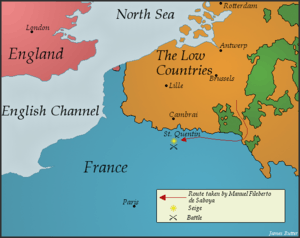Battle of St. Quentin (1557)
The Battle of Saint-Quentin of 1557, was a decisive engagement, during the Italian War of 1551–1559, between the Kingdom of France and the Habsburg empire at Saint-Quentin in Picardy. A Habsburg Spanish force under Duke Emmanuel Philibert of Savoy defeated a French army under the command of Duke Louis Gonzaga and Duke Anne de Montmorency.
| Battle of St. Quentin | |||||||
|---|---|---|---|---|---|---|---|
| Part of the Italian War of 1551–1559 | |||||||
 Map of Emmanuel Philibert, Duke of Savoy's Dutch campaign | |||||||
| |||||||
| Belligerents | |||||||
|
|
| ||||||
| Commanders and leaders | |||||||
|
|
| ||||||
| Strength | |||||||
|
60,000[1]–80,000[1] 7,000 English troops[2] | 26,000[3] | ||||||
| Casualties and losses | |||||||
| 1,000 | 3,000 killed and 7,000 captured[1] or 14,000[3] | ||||||
Battle
The battle took place on the Feast Day of St. Lawrence 10 August.[2] Philibert, with his English allies,[lower-alpha 1][lower-alpha 2] had placed St. Quentin under siege. Montmorency with a force of around 26,000 men marched to St. Quentin to relieve the city.[2] Facing a force twice their size, Montmorency attempted to gain access to St. Quentin through a marsh, but a delayed French withdrawal allowed the Spanish to defeat the French and capture Montmorency.[2]
During the battle the Saint-Quentin collegiate church was badly damaged by fire.[7]
After the victory over the French at St. Quentin, "the sight of the battlefield gave Philip a permanent distaste for war"; he declined to pursue his advantage, withdrawing to the Spanish Netherlands to the north,[2] where he had been the Governor since 1555. The Treaty of Cateau-Cambresis ended the war two years later.[8]
Feast of Saint Lawrence
Being of a grave religious bent, Philip II was aware that 10 August is the Feast of St Lawrence, a Roman deacon who was roasted on a gridiron for his Christian beliefs. Hence, in commemoration of the great victory on St Lawrence’s Day, Philip sent orders to Spain that a great palace in the shape of a gridiron should be built in the Guadarrama Mountains northwest of Madrid. Known as El Escorial, it was finally completed in 1584.
Notes
- Henry Kamen, Philip of Spain (1997) gives a brief account based on contemporary sources, noting that Spanish troops constituted about 10% of the Habsburg total. Kamen claims that the battle was "won by a mainly Netherlandish army commanded by the non-Spaniards the duke of Savoy and the earl of Egmont".[4] On the other hand, Geoffrey Parker states that Spanish troops were decisive in defeating the French at St. Quentin owing to their high value, as well as in defeating the Ottomans at Hungary in 1532 and at Tunis in 1535, and the German protestants at Mühlberg in 1547.[5]
- England had entered the war at the behest of Phillip II, on 7 June 1557.[6]
References
- Bonner 1992, p. 35.
- Tucker 2010, p. 518.
- Nolan 2006, p. 756.
- Kamen 1997, p. 28.
- Parker 1989, p. 41.
- Leathes 1907, p. 92.
- Klaiber 1993, p. 186.
- Wilson 2016, p. 742.
Sources
- Bonner, E.A. (1992). "Continuing the 'Auld Alliance' in the Sixteenth Century". In Simpson, Grant G. (ed.). The Scottish Soldier Abroad, 1247-1967. Rowman & Littlefield.CS1 maint: ref=harv (link)
- Kamen, Henry (1997). Philip of Spain. Yale University Press.CS1 maint: ref=harv (link)
- Klaiber, Susan (1993). Guarino Guarini's Theatine Architecture. Columbia University Press.CS1 maint: ref=harv (link)
- Leathes, Stanley (1907). "Habsburg and Valois". In Ward, Adolphus William (ed.). The Cambridge Modern History. 10. Cambridge University Press.CS1 maint: ref=harv (link)
- Nolan, Cathal J. (2006). The Age of Wars of Religion, 1000-1650: An Encyclopedia of Global Warfare and Civilization. 2. Greenwood Publishing Group.CS1 maint: ref=harv (link)
- Parker, Geoffrey (1989). España y la rebelión de Flandes. Nerea.CS1 maint: ref=harv (link)
- Tucker, Spencer C., ed. (2010). "August 10, 1557". A Global Chronology of Conflict: From the Ancient World to the Modern Middle East. II. ABC-CLIO.CS1 maint: ref=harv (link)
- Wilson, Peter H. (2016). Heart of Europe: A History of the Holy Roman Empire. Harvard University Press.CS1 maint: ref=harv (link)